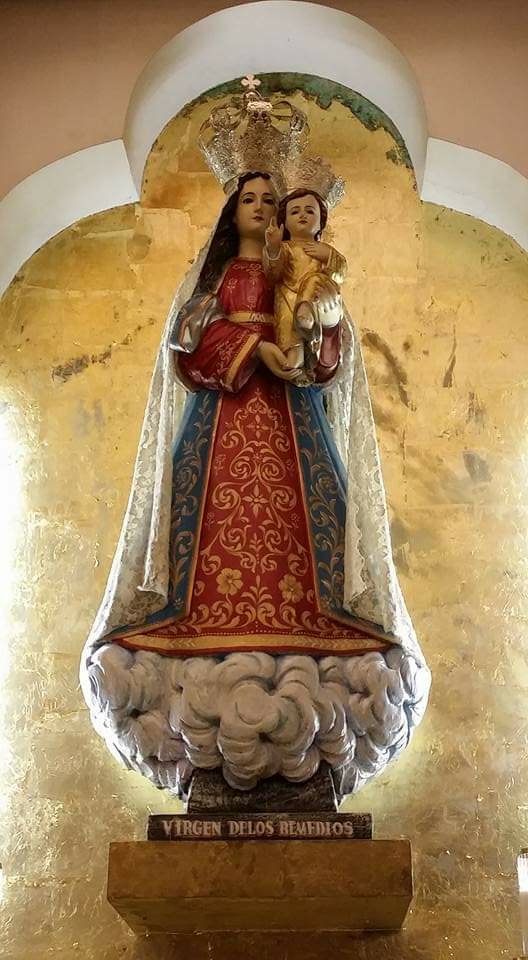
We might be familiar with the narrative of Ferdinand Magellan giving the image of the Santo Niño de Cebu to Reina Juana on April 14, 1521, yet with recent studies on this event, we found out that there were two more images that Magellan gave to the Cebuanos – The bust image of El Ecce Homo that can still be seen today and the lost image of Nuestra Señora de los Remedios, also known as “Birhen sa Kotta” which was unfortunately lost during the onslaught of the Second World War. Now as we are celebrating the 500 Years of the Catholic Faith in our country, let us have look on one of the lost devotions and heritage of our faith and how the devotion would influence the Marian piety of Cebu a few centuries later, despite of it’s loss.
The Image

The petite image of the Blessed Mother, known as Nuestra Señora de los Remedios, or more popularly known at the time as “Birhen sa Kotta” of Cebu is that of the Blessed Virgin in the Madonna and Child model where the Child Jesus is resting in the arms of the Blessed Virgin Mary and the Virgin in turn sweetly looked at her Son resting. The Virgin and Child wears Hebraic robes while the Virgin wears a long mantle from head to toe. The Mother and Child stands on a cloud base with a putti (an angel depicted only with a head and wings) facing the faithful, a rafaga (rays of light) at the back of the image and crowns on their heads. Interestingly, in one of the two existing photographs of the image, the image was also vested with nicely embroidered vestments for both Mother and Child and a veil for the Virgin that also covers her Son with crowns on their heads.
The Magellan Narrative

As we begin the narrative of the Nuestra Señora de los Remedios de Cebu, we must go back to March 14, 1521 with the First Baptism in the Philippines held in Cebu where after Ferdinand Magellan eagerly gave Catholic instruction to the natives and baptized Rajah Humabon as “Carlos”, in honor of Carlos V, the King of Spain at that time and to his wife Hara Humamay (as what some scholars identified) was given the name “Juana”. After the Sacrament of Baptism was completed, Ferdinand Magellan gave Reina Juana three images: The famous Santo Niño de Cebu, a bust of El Ecce Homo and the image of the Madonna and Child which will later be known as Nuetra Señora de los Remedios. According to Antonio Pigafetta’s chronicles: “She was shown an image of Our Lady, a very wooden image of the Child Jesus, and a Cross (some scholars would later note it was the bust image of the El Ecce Homo). Thereupon she was overcome with contrition, and asked for baptism amid her tears.”
This beautiful contact with Christianity would come to an end with the Battle of Mactan where Magellan died in the hands of warriors headed by Lapu Lapu on April 27, 1521 and the Spaniards left to continue their journey to the Moluccas and returned to Spain which led to the first recorded circumnavigation of the world.
The Discovery and Devotion

By the time Miguel Lopez de Legazpi set foot to the Philippines in 1565, he and his crew built Fort San Pedro as a military defense from rogue natives and Moro pirates. During the construction, the image of “Birhen sa Cotta sa Sugbo” was found floating inside a well located inside the fort around the years 1572-1575. The discovery of the image inside the Spanish fort’s fresh water well lent it the title Nuestra Señora de la Cotta, the Lady of the Fort, and was first enshrined at the garrison’s chapel.
It is certain that when the expedition of Legazpi arrived 44 years later, there were no Christians left. It is believed that to despise the Catholic religion or for fear of other idolaters, the new converts tried to get rid of the statue of Our Lady given by Pigefetta to the Queen. So they tried to bury the image in the place where many years later she was found.

The venerated image gained many devotees since then. The waters from the well were also said to have miraculous properties that due the cures attributed to Virgin, she was given the name “Nuestra Senora delos Remedios”. It was only by the middle of the 1800’s that the image was transferred to the Cebu Metropolitan Cathedral in the Capilla del Bautisterio, carrying with it the reputation of being miraculous. Her feast day was then celebrated every December 18.
The Unfortunate Oblivion and Keeping the memory of the lost Virgin

The devotion to the Birhen saKotta would come on a screeching halt when the Cathedral of Cebu was bombed during the Second World War. The Cathedral was heavily damaged and it is believed that the image was one of the casualties yet there were several unverified stories that are circulating for years that the image was spared and the whereabouts of the this miraculous image were unknown. From here, the devotion to the Nuestra Señora de los Remedios declined, probably due to the loss of the original image. However, efforts were made to keep the devotion alive with two replacement images that were commissioned, one in the Metropolitan Cathedral of Cebu where the the new image is enshrined in one of it’s altars and the other in Fort San Pedro. donated by a benefactor as a reminder of the origin of the image.
Interestingly, there are parishes in Cebu that were established and dedicated to the Blessed Virgin Mary as Nuestra Señora de los Remedios, particularly in Labangon, Cebu City; Odlot, Bogo City and in Guindarohan, Minglanilla and they celebrate their feasts on the month of December, perhaps as a reminder of the older devotion that once thrived in Cebu. It is also noteworthy that the devotion to Nuestra Señora de los Remedios of Labangon and most especially in Odlot have gained a devotional following due to the miracles reported through the help of the Virgin that the images of Labangon and Odlot received the honor of episcopal coronation in 2010 and 2014 respectively.
It may seem that the devotion to the Nuestra Señora de los Remedios – Birhen sa Kotta was lost since the Second World War, it’s influence on the present popular Marian piety of Cebu can still be seen with the new images and parishes dedicated to her. As we celebrate the 500 Years of Christianity in our land, let us also celebrate the legacy of the Birhen sa Kotta sa Sugbu because the gifing of this Marian image by Magellan can be see as a precursor of the country’s love for the Blessed Virgin Mary that centuries later, the Philippines will be called “Pueblo Amante de Maria” because of the strong devotion we have to the Mother of God and for the love protection that she bestowed in these islands for the last 500 Years.
References
Aviado, Lutgarda, “Madonnas of the Philippines”, Manlapaz Press, Quezon City, 1972.
Mojres, Resil, “The Feast of the Santo Niño, An Introduction of the History of a Cebuano Devotion”, University of San Carlos Press, Cebu, 2017.
Sanchez, Francisco, “La Virgen Maria Venerada en sus Imagenes Filipinas”, Manila: Imp. De Santos y Bernal, 1904.
Vengco, Sabino Jr., “Shaping the Filipino Marian Piety”, St. Paul’s Publications, 2019.
Photos and Artworks
Carreon, Ryan
Prroquia de la Nuestra Señora de los Remedios de Guindarohan Facebook page
Yu, Kendrick Dominic of La Sagrada Expedicion
+AMDG+ +AMPSPC+
This blog post is dedicated to my good friends Dr. Peter Nepomuceno, Rev. Fr. Arnold Sta. Maria Cañoza who left this world due to complications of COVID-19, to Roi Peralta who ended his bout with a long term illness and to all who succumbed to COVID-19. May Our Lord and Our Lady welcome them to their loving arms in heaven as we pray for the repose of their souls.



1 Comment